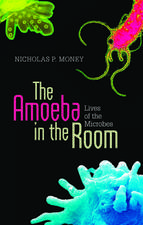Arabidopsis Protocols, 2nd Edition: Methods in Molecular Biology, cartea 323
Editat de Julio Salinas, Jose J. Sanchez-Serranoen Limba Engleză Paperback – 9 dec 2010
| Toate formatele și edițiile | Preț | Express |
|---|---|---|
| Paperback (1) | 813.94 lei 38-44 zile | |
| Humana Press Inc. – 9 dec 2010 | 813.94 lei 38-44 zile | |
| Hardback (1) | 965.52 lei 6-8 săpt. | |
| Humana Press Inc. – 15 mar 2006 | 965.52 lei 6-8 săpt. |
Din seria Methods in Molecular Biology
- 9%
 Preț: 791.63 lei
Preț: 791.63 lei - 23%
 Preț: 598.58 lei
Preț: 598.58 lei - 20%
 Preț: 882.98 lei
Preț: 882.98 lei -
 Preț: 252.05 lei
Preț: 252.05 lei - 5%
 Preț: 802.70 lei
Preț: 802.70 lei - 5%
 Preț: 729.61 lei
Preț: 729.61 lei - 5%
 Preț: 731.43 lei
Preț: 731.43 lei - 5%
 Preț: 741.30 lei
Preț: 741.30 lei - 5%
 Preț: 747.16 lei
Preț: 747.16 lei - 15%
 Preț: 663.45 lei
Preț: 663.45 lei - 18%
 Preț: 1025.34 lei
Preț: 1025.34 lei - 5%
 Preț: 734.57 lei
Preț: 734.57 lei - 18%
 Preț: 914.20 lei
Preț: 914.20 lei - 15%
 Preț: 664.61 lei
Preț: 664.61 lei - 15%
 Preț: 654.12 lei
Preț: 654.12 lei - 18%
 Preț: 1414.74 lei
Preț: 1414.74 lei - 5%
 Preț: 742.60 lei
Preț: 742.60 lei - 20%
 Preț: 821.65 lei
Preț: 821.65 lei - 18%
 Preț: 972.30 lei
Preț: 972.30 lei - 15%
 Preț: 660.49 lei
Preț: 660.49 lei - 5%
 Preț: 738.41 lei
Preț: 738.41 lei - 18%
 Preț: 984.92 lei
Preț: 984.92 lei - 5%
 Preț: 733.29 lei
Preț: 733.29 lei -
 Preț: 392.60 lei
Preț: 392.60 lei - 5%
 Preț: 746.26 lei
Preț: 746.26 lei - 18%
 Preț: 962.66 lei
Preț: 962.66 lei - 23%
 Preț: 860.22 lei
Preț: 860.22 lei - 15%
 Preț: 652.64 lei
Preț: 652.64 lei - 5%
 Preț: 1055.50 lei
Preț: 1055.50 lei - 23%
 Preț: 883.87 lei
Preț: 883.87 lei - 5%
 Preț: 1141.13 lei
Preț: 1141.13 lei - 19%
 Preț: 491.89 lei
Preț: 491.89 lei - 5%
 Preț: 1038.86 lei
Preț: 1038.86 lei - 5%
 Preț: 524.16 lei
Preț: 524.16 lei - 18%
 Preț: 2122.34 lei
Preț: 2122.34 lei - 5%
 Preț: 1299.23 lei
Preț: 1299.23 lei - 5%
 Preț: 1339.12 lei
Preț: 1339.12 lei - 18%
 Preț: 1390.26 lei
Preț: 1390.26 lei - 18%
 Preț: 1395.63 lei
Preț: 1395.63 lei - 18%
 Preț: 1129.65 lei
Preț: 1129.65 lei - 18%
 Preț: 1408.26 lei
Preț: 1408.26 lei - 18%
 Preț: 1124.92 lei
Preț: 1124.92 lei - 18%
 Preț: 966.27 lei
Preț: 966.27 lei - 5%
 Preț: 1299.99 lei
Preț: 1299.99 lei - 5%
 Preț: 1108.51 lei
Preț: 1108.51 lei - 5%
 Preț: 983.76 lei
Preț: 983.76 lei - 5%
 Preț: 728.16 lei
Preț: 728.16 lei - 18%
 Preț: 1118.62 lei
Preț: 1118.62 lei - 18%
 Preț: 955.25 lei
Preț: 955.25 lei - 5%
 Preț: 1035.62 lei
Preț: 1035.62 lei
Preț: 813.94 lei
Preț vechi: 1070.97 lei
-24% Nou
Puncte Express: 1221
Preț estimativ în valută:
155.77€ • 169.14$ • 130.84£
155.77€ • 169.14$ • 130.84£
Carte tipărită la comandă
Livrare economică 18-24 aprilie
Preluare comenzi: 021 569.72.76
Specificații
ISBN-13: 9781617375392
ISBN-10: 161737539X
Pagini: 496
Ilustrații: 496 p. 136 illus., 1 illus. in color.
Dimensiuni: 178 x 254 x 26 mm
Greutate: 0.92 kg
Ediția:Softcover reprint of hardcover 2nd ed. 2006
Editura: Humana Press Inc.
Colecția Humana
Seria Methods in Molecular Biology
Locul publicării:Totowa, NJ, United States
ISBN-10: 161737539X
Pagini: 496
Ilustrații: 496 p. 136 illus., 1 illus. in color.
Dimensiuni: 178 x 254 x 26 mm
Greutate: 0.92 kg
Ediția:Softcover reprint of hardcover 2nd ed. 2006
Editura: Humana Press Inc.
Colecția Humana
Seria Methods in Molecular Biology
Locul publicării:Totowa, NJ, United States
Public țintă
ResearchCuprins
Growing Arabidopsis.- Growth of Plants and Preservation of Seeds.- Prevention and Control of Pests and Diseases.- Growth of Other Species Related to Arabidopsis thaliana.- Grafting.- Synchronization, Transformation, and Cryopreservation of Suspension-Cultured Cells.- Genetic Analyses.- Genetic Analysis.- QTL Analysis.- EMS Mutagenesis of Arabidopsis.- Low-Resolution Mapping of Untagged Mutations.- Gene Identification and Cloning by Molecular Marker Mapping.- High-Throughput TILLING for Arabidopsis.- Genotyping and Mapping With High-Density Oligonucleotide Arrays.- Forward Genetic Screening of Insertional Mutants.- PCR-Based Screening for Insertional Mutants.- Cytogenetic Analyses of Arabidopsis.- Using Information From Public Arabidopsis Databases to Aid Research.- Transient and Stable Transformation.- In Planta Agrobacterium-Mediated Transformation by Vacuum Infiltration.- Transient Expression Assay by Agroinfiltration of Leaves.- Functional Analysis of Transcription Factors by Microparticle Bombardment.- Transfection Assays With Protoplasts Containing Integrated Reporter Genes.- Chloroplast Genetic Engineering Via Organogenesis or Somatic Embryogenesis.- ?-Glucuronidase as Reporter Gene.- Use of Fluorescent Proteins as Reporters.- Luciferases as Reporter Genes.- Aequorin as a Reporter Gene.- Applications of Chemical-Inducible Expression Systems in Functional Genomics and Biotechnology.- Transcriptomics.- RNA Extraction.- Target Preparation for DNA Microarray Hybridization.- Statistical Issues in Microarray Data Analysis.- Preparation and Quality Assessment of RNA From Cell-Specific Samples Obtained by Laser Microdissection.- Proteomics.- Protein Isolation and Second-Dimension Electrophoretic Separation.- Isolation of Nuclear Proteins.- Purification and Fractionationof Membranes for Proteomic Analyses.- Protein Microsequencing.- Peptide-Based Phosphoproteomics With Immobilized Metal Ion Chromatography.- Metabolomics.- Metabolite Profiling in Arabidopsis.- Hormone Profiling in Arabidopsis.
Recenzii
From the reviews of the first edition:
". . .a comprehensive collection of significant new methods as well as updated standard protocols. . .written by experienced authors and internationally recognized experts."-Journal of Plant Physiology
"...recommend[ed]...provides a set of enduring methods and is comprehensive enough for instant use in the lab" -Trends in Plant Science
"...a 'must have' for every laboratory involved in Arabibopsis" -Quarterly Review of Biology
"...a 'must' for those labs working with not just Arabidopsis specifically but plants in general..." -Microbiology Today
"...a must for anybody moving into the Arabidopsis field and setting up a new lab...extremely useful" -Genetical Research
"...especially valuable for detailed step-by-step procedures including many important notes...an indispensable guide, which should be at reach on the shelf in each laboratory where the plant molecular-genetic methods in Arabidopsis, and not only Arabidopsis, are used."- Biologia Plantarum
"...should prove to be highly helpful laboratory companion for beginners and established researchers in molecular biology, particularly those whose research deal with Arabidopsis and related plants." - Plant Science Bulletin
From the reviews of the second edition:
"Arabidopsis Protocols is another volume in Humana’s series, Methods in Molecular Biology. … It is … important to provide both experienced researchers and those new to the use of Arabidopsis, with single volumes that describe a wide range of experimental protocols. This book does that admirably. It is written by renowned experts in their respective fields … . Most chapters include useful Figures to illustrate the text. So I would heartily recommend this to any lab serious about carrying out work with Arabidopsis … ." (Keith Lindsey, Molecular Biotechnology, Vol. 36, 2007)
". . .a comprehensive collection of significant new methods as well as updated standard protocols. . .written by experienced authors and internationally recognized experts."-Journal of Plant Physiology
"...recommend[ed]...provides a set of enduring methods and is comprehensive enough for instant use in the lab" -Trends in Plant Science
"...a 'must have' for every laboratory involved in Arabibopsis" -Quarterly Review of Biology
"...a 'must' for those labs working with not just Arabidopsis specifically but plants in general..." -Microbiology Today
"...a must for anybody moving into the Arabidopsis field and setting up a new lab...extremely useful" -Genetical Research
"...especially valuable for detailed step-by-step procedures including many important notes...an indispensable guide, which should be at reach on the shelf in each laboratory where the plant molecular-genetic methods in Arabidopsis, and not only Arabidopsis, are used."- Biologia Plantarum
"...should prove to be highly helpful laboratory companion for beginners and established researchers in molecular biology, particularly those whose research deal with Arabidopsis and related plants." - Plant Science Bulletin
From the reviews of the second edition:
"Arabidopsis Protocols is another volume in Humana’s series, Methods in Molecular Biology. … It is … important to provide both experienced researchers and those new to the use of Arabidopsis, with single volumes that describe a wide range of experimental protocols. This book does that admirably. It is written by renowned experts in their respective fields … . Most chapters include useful Figures to illustrate the text. So I would heartily recommend this to any lab serious about carrying out work with Arabidopsis … ." (Keith Lindsey, Molecular Biotechnology, Vol. 36, 2007)
Textul de pe ultima copertă
Emulating the much-praised first edition of Arabidopsis Protocols, leading scientists have generated an up-to-date work that reflects recent advances in plant biology, the completion of the Arabidopsis genome sequence-essential for studying plant function-and the development of whole systems approaches that allow global analysis of gene expression, as well as protein and metabolite dynamics. The authors have included nearly all techniques developed in Arabidopsis, others recently adapted from more traditional work in crop species, and the latest using Arabidopsis as a model system. Highlights include the most recent methods-transcriptomics, proteomics, and metabolomics-and their novel applications (phosphoproteomics, DNA microarray-based genotyping, high throughput metabolite profiling, and single-cell RNA). Traditional protocols from the agricultural sciences and others developed in crop species (grafting and chloroplast transformation) have been adapted to exploit the advantages of the Arabidopsis model. The protocols themselves follow the successful Methods in Molecular Biology™ series format, each offering step-by-step laboratory instructions, an introduction outlining the principles behind the technique, lists of the necessary equipment and reagents, and tips on troubleshooting and avoiding known pitfalls.
Indispensable and highly practical, Arabidopsis Protocols, Second Edition offers both novice and experienced plant biologists cutting-edge tools to explore new scenarios and gain an understanding of how this complex, multicellular organism works, how it copes with a sessile life style, and how these strategies compare with those developed in other organisms.
Indispensable and highly practical, Arabidopsis Protocols, Second Edition offers both novice and experienced plant biologists cutting-edge tools to explore new scenarios and gain an understanding of how this complex, multicellular organism works, how it copes with a sessile life style, and how these strategies compare with those developed in other organisms.
Caracteristici
Includes supplementary material: sn.pub/extras















